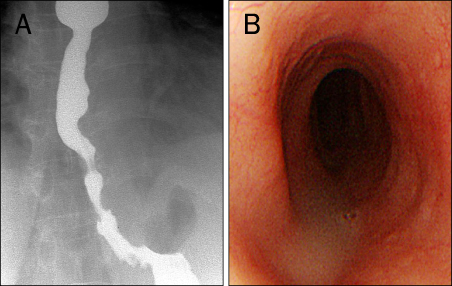Korean J Gastroenterol.
2012 Aug;60(2):109-112. 10.4166/kjg.2012.60.2.109.
Symptomatic Improvement of Diffuse Esophageal Spasm after Botulinum Toxin Injection
- Affiliations
-
- 1Department of Internal Medicine, Bucheon Hospital, Soonchunhyang University College of Medicine, Bucheon, Korea. sjhong@schmc.ac.kr
- KMID: 1387339
- DOI: http://doi.org/10.4166/kjg.2012.60.2.109
Abstract
- Diffuse esophageal spasm, an uncommon esophageal motility disorder, has recently been defined using high-resolution manometry. Patients with distal esophageal spasm usually complain of chest pain or dysphagia. The etiology and pathophysiology of this disorder are poorly known, and treatment options are limited. However, some options to improve symptoms are available, including endoscopic injection of botulinum toxin. Nevertheless, few reports have described the effects of endoscopic injection of botulinum toxin in patients with symptomatic diffuse esophageal spasm with clear endoscopic and high-resolution manometry images. Here, we report a case of diffuse esophageal spasm diagnosed with high-resolution manometry and treated by endoscopic injection of botulinum toxin with good results at the 7-month follow-up.
MeSH Terms
Figure
Reference
-
1. Dalton CB, Castell DO, Hewson EG, Wu WC, Richter JE. Diffuse esophageal spasm. A rare motility disorder not characterized by high-amplitude contractions. Dig Dis Sci. 1991. 36:1025–1028.2. Konturek JW, Thor P, Lukaszyk A, Gabryelewicz A, Konturek SJ, Domschke W. Endogenous nitric oxide in the control of esophageal motility in humans. J Physiol Pharmacol. 1997. 48:201–209.3. Storr M, Allescher HD, Rosch T, Born P, Weigert N, Classen M. Treatment of symptomatic diffuse esophageal spasm by endoscopic injections of botulinum toxin: a prospective study with long-term follow-up. Gastrointest Endosc. 2001. 54:754–759.4. Song CS, Seong EY, Kim GH, et al. The incidence of esophageal disease in patients with Non-Cardiac chest pain. Korean J Gastroenterol. 1997. 30:141–147.5. Kim DW, Jung YS, Choi P, et al. Esophageal manometric findings of 1,746 patients with esophageal symptoms. Korean J Gastrointest Motil. 2003. 9:18–24.6. Hong SJ. A 47-year-old woman with Dysphagia and food getting stuck: what is your impression? J Neurogastroenterol Motil. 2010. 16:440–441.7. Choi KW, Paik SW, Rhee JC, et al. Clinical characteristics of diffuse esophageal spasm. Korean J Gastroenterol. 1998. 31:717–723.8. Siegel CI, Hendrix TR. Esophageal motor abnormalities induced by acid perfusion in patients with heartburn. J Clin Invest. 1963. 42:686–695.9. Clouse RE, Eckert TC. Gastrointestinal symptoms of patients with esophageal contraction abnormalities. Dig Dis Sci. 1986. 31:236–240.10. Orlando RC, Bozymski EM. Clinical and manometric effects of nitroglycerin in diffuse esophageal spasm. N Engl J Med. 1973. 289:23–25.11. Kim YK, Kang YW. Clinical and manometric findings of diffuse esophageal spasm. Korean J Med. 1995. 49:598–603.12. Pandolfino JE, Ghosh SK, Rice J, Clarke JO, Kwiatek MA, Kahrilas PJ. Classifying esophageal motility by pressure topography characteristics: a study of 400 patients and 75 controls. Am J Gastroenterol. 2008. 103:27–37.13. Kahrilas PJ, Ghosh SK, Pandolfino JE. Esophageal motility disorders in terms of pressure topography: the Chicago Classification. J Clin Gastroenterol. 2008. 42:627–635.14. Pandolfino JE, Fox MR, Bredenoord AJ, Kahrilas PJ. High-resolution manometry in clinical practice: utilizing pressure topography to classify oesophageal motility abnormalities. Neurogastroenterol Motil. 2009. 21:796–806.15. Grübel C, Borovicka J, Schwizer W, Fox M, Hebbard G. Diffuse esophageal spasm. Am J Gastroenterol. 2008. 103:450–457.16. Tutuian R, Castell DO. Review article: oesophageal spasm - diagnosis and management. Aliment Pharmacol Ther. 2006. 23:1393–1402.17. Ebert EC, Ouyang A, Wright SH, Cohen S, Lipshutz WH. Pneumatic dilatation in patients with symptomatic diffuse esophageal spasm and lower esophageal sphincter dysfunction. Dig Dis Sci. 1983. 28:481–485.18. París F, Guijarro R, Blasco E, et al. Long term results of surgery in diffuse, idiopathic, symptomatic esophageal spasm. Rev Esp Enferm Apar Dig. 1984. 66:497–507.19. Fishman VM, Parkman HP, Schiano TD, et al. Symptomatic improvement in achalasia after botulinum toxin injection of the lower esophageal sphincter. Am J Gastroenterol. 1996. 91:1724–1730.20. Pasricha PJ, Ravich WJ, Hendrix TR, Sostre S, Jones B, Kalloo AN. Intrasphincteric botulinum toxin for the treatment of achalasia. N Engl J Med. 1995. 332:774–778.
- Full Text Links
- Actions
-
Cited
- CITED
-
- Close
- Share
- Similar articles
-
- Botulinum Toxin Injection Treatment for Facial Spasm
- Factors involved in the Transition from Achalasia to Nutcracker Esophagus or Diffuse Esophageal Spasm after Intrasphincteric Injection of Botulinum Toxin
- Botulinum Toxin Injection for Achalasia and Non-achalasia Esophageal Motility Disorders
- Botulinum Toxin A Treatment for Patients with Periorbital Spasm after Facial Nerve Paresis
- Treatment of Blepharospasm and Hemifacial apasm with Botulinum Toxin A(Oculinum(R))(I)




